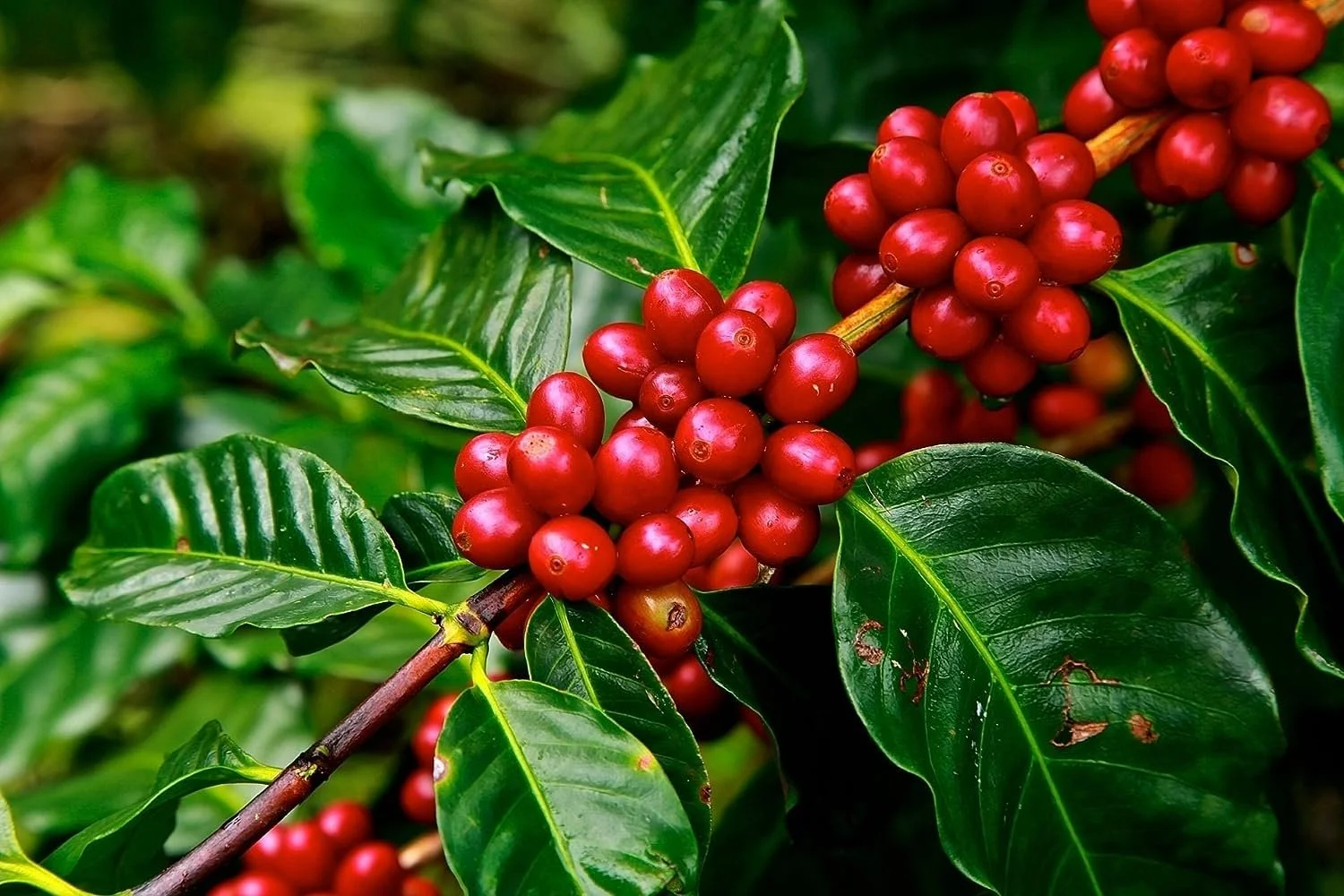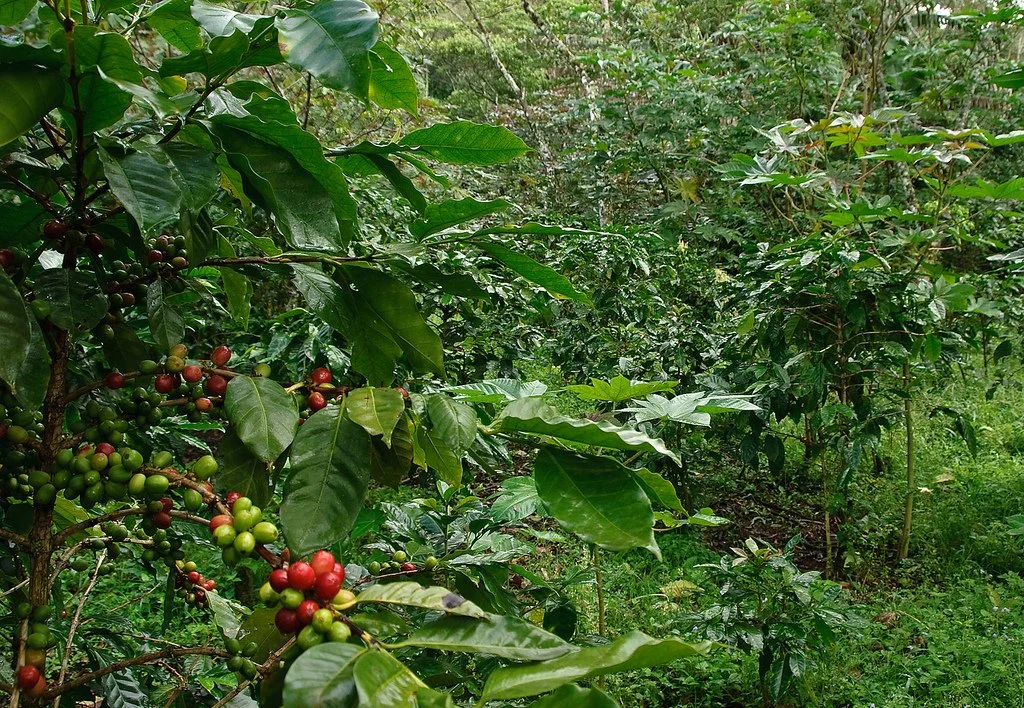WHY SHADE GROWN COFFEE IS BETTER FOR THE ENVIRONMENT
Image courtesy of SMK Koran 1
Coffee is the second highest traded commodity after crude oil and Coffee is the second most frequently consumed beverage in the U.S., after water. Coffee takes the lead as a water intensive crop. According to the Institute for Water Education, August 2003, a 125 ml cup of coffee requires 140 liters (37 gallons) of water; so how can it be grown sustainably? Most commercial coffee, known as Sun Coffee, are grown in fields which has a high yield rate, ripens faster, but at the cost of higher water consumption, lower tolerance to temperature changes, drought, soil degradation and susceptibility to diseases and pest (Berry Borer Bug).
Indiscriminate fires are used to clear the land of bush and trees to harvest neat parallel rows of tamed coffee plants. Some farmers use this blitzkrieg method to clear virgin tropical forest to rapidly gain access to organic farm land which enable coffee distributers to charge higher prices for an organic commodity. Legacy farm land would have to go through years of time consuming rehabilitation avoiding the use of: pesticides, synthetic fertilizers, herbicides, soil tilling, or just giving the land a rest before it could earn the coveted title of an organic coffee farm.
A sustainable alternative to monoculture coffee farming is shade cultivation. You see, coffee is a social plant, it evolved to be grown next to other flowering plants and under trees that provide shade from the hot sun, prevent soil erosion on mountains and provide habitats for wildlife. Birds and Bats feed on pest that would otherwise harm the coffee plant. In a biodiverse forest, multiple crops can be grown next to each other; fruit trees, vegetables . . . If one crop has a low yield, in one season, maybe the other crops may have a higher yield. The forest trees perform alchemy sequestering carbon from the air, while nitrogen fixing roots & rhizosphere help their neighbors. Less irrigation is needed since the fallen tree leaves create a mulch that retains moisture in the soil by reducing evaporation. Biodiversity facilitates beneficial microorganisms in the soil. This traditional way of coffee shade farming produces a coffee plant that ripens slower but is more tolerant to pest and diseases.
Even the pulp waste from the cherry fruit which encases the coffee seed has the potential to be harvested in to food or even clothing. The cherry pulp is high in fiber, protein, antioxidants and minerals. Usually, the wasted mounds of decomposing pulp would release the Greenhouse gas methane which acidify the soil and contaminate ground water.
Image courtesy of Keys Coffee Co.
MYTH BUSTERS
The coffee “seed” encased inside a cherry fruit is incorrectly called a bean. Beans are Legumes; instead of growing inside a fruit, Legumes grow inside a pod.
Expresso coffee is a method (Pressure method) of brewing coffee and not a type of coffee seed. The high pressure brewing method extracts more oils with the hot water creating a stronger, smoother, flavor.
Coffee is not inherently a stimulant, but it does suppress fatigue. How is this possible; well our bodies have a biological clock that releases a chemical called Adenosine as the sunlight fades in the evening. The Adenosine binds with receptors in the brain to inhibit the release of natural stimulants like Adrenaline or Epinephrine. The caffiene found in coffee is chemically similar to Adenosine tricking the receptors in the brain, preventing the suppression of the stimulants—keeping us awake.
Arabica has about 1.7% of caffeine while the Robusta boast 2.5% of caffeine. Decaffeinated coffee does contain insignificant amounts of caffeine; the decaffeination process removes the caffeine with 5 - 10mg of residual caffeine remaining. And while we are on the subject, Black Tea has half the amount of caffeine as a cup of Coffee.
GENESIS
The Genus - Coffea, originated in south west Ethiopia along the Great Rift Valley; where the Human species evolved—the two species were destined to be together; 🤣. The two most common commercialized species of coffee are Arabica and Canephora (Robusta). Arabica grows at higher elevations with cooler temperatures, less rain and has a softer, fruity, taste with more acidity; while the latter has a stronger, bitter, flavor with less acidity and more caffeine. Robusta is preferable for producing instant or Espresso coffee. Robusta is known for disease resistance, and climate tolerance, however, Climate Change is impacting both species through disease, droughts and extreme heat.
Ethiopian Arabica was later grown in Yemen, where it earned its Arabic associated name. The Dutch, then later the French, were responsible for exporting Arabica coffee around the world. There are still 2,000 - 3,000 old world varieties remaining in Ethiopia; while the rest of the world are populated with only a dozen varieties mostly from hybrids and seeds of the original plants first taken from Ethiopia and Yemen to Europe.
Old world coffee varieties from Africa, Madagascar and South East Asai are less susceptible to diseases such as Rust that is impacting the commercialized Arabica and Robusta varieties. Although old world coffee varieties may be a viable alternative, they will have to satisfy accustomed taste buds along with productivity challenges to be commercially competitive.
Coffee is processed by washing or milling the fruit to remove the cherry from the seed. The seed is then dried in the sun naturally shedding the parchment skin (Green coffee). The most critical step in processing is roasting (Cooking) the seed. This stage in the process (Maillard Reaction) uses heat to combine sugars from Fructose along with Amino Acids from Proteins to form—drum roll—flavors and caramelization. The dried seed has a long shelf life but the flavors and shelf life starts to degrade once the roasting process is finished.
CHEMISTRY
Coffee richness depends on a handful of factors one of which is the growing altitude. Low Altitude coffee, like plants grown in Brazil have access to more oxygen which reflects in their robust flavors. Coffee grown in higher altitudes like Somalia compensate for the limited available oxygen by producing more lactic acid to create energy through anarobic respiration. This creates the most desired floral and fruitier flavors.
During the roasting processing, the longer the coffee seed roast (Second crack), more oil will surface on the seed creating a darker color and smoky flavor. Lighter roast (First crack) coffees retain more of the original flavor and caffeine. It maybe counterintuitive for commercial coffee makers to ruin the coffee flavor by extra roasting, almost burning, the coffee seeds. However, this creates an, albeit bitter, flavor that can be sold around the world with consistency, then flavored with added syrups or toppings at serving by a Barista.
Water chemistry is important when brewing the perfect cup of coffee. Hard water has positive ions (Mg, Ca, Na) that bond to the negative ions (Caffeine) found in coffee and are extracted in to the brewing water; creating a richer tasting, smoother texture coffee.
COFFEE MAKERS
The two methods of brewing coffee uses either gravity or forced pressure. The best method is the method that makes a good tasting cup of coffee for you. Filtered coffee or Chemix, is considered healthier since the percolation removes substances that elevate cholesterol. Only the most soluble parts of the coffee are obtained. While the French press or Expresso method allows these substances to remain in the coffee. The French press uses full immersion; allowing the water and coffee to mingle for a longer time dissolving more soluble and insoluble parts (Oils) of the coffee. Both methods allow the used coffee seeds and some biodegradable filters to be composted.
At the risk of being a purest in this research, commercial disposable coffee pods were excluded for participation in this research since the purpose of the new packaging methods are not intended to enhance taste, texture or aroma but to seduce consumers in to purchasing a new “proprietary” coffee dispensing machine. The use of disposable coffee pods create packaging waste while valuable resources are used to build specific coffee dispensing machines that are only as good as the next, newest, obsolescent model.
DISPOSABLE CUPS
The inside of most “disposable” paper beverage cups are lined with a thin layer of plastic to prevent the hot fluids from leaking through the paper cup. Then there are the Polystyrene lids and cardboard sleeves to protect hands holding hot beverage cups from thermal burns.
According to Clean Water Action, the U.S. uses some 130 billion disposable cups per year.
Millions of coffee cups end up in our Oceans, landfills polluting the environment. Even if a coffee cup makes it to recycling, there is not a financially feasible way of separating both the thin plastic (Polyethylene) liner from the paper cup for mutual recycling.
A viable option is if Baristas are able to dispense beverages using customers reusable cups or insulated thermos. However, at the consternation of some Baristas, dispensing standard volume beverages in to customers individual containers, with their various volume sizes, disrupts the operational convenience of using company standard cups. Customers should be considerate & hygienic by fully cleaning their cups before handing it over to a Barista for serving. An alternative are coffee cup swap programs such as HuskeeSwap. Customers return reusable cups to the coffee shop for professional cleaning then receive their beverage in another prewashed cup.
While small & cooperative owned coffee farmers and workers face economic exploitation, large coffee corporations are making the most profits. This can be mitigated by consumers using their purchasing power in favor of sustainably sourced and fair labor coffee farms.
Please share your thoughts or experiences in the Comments section below.

